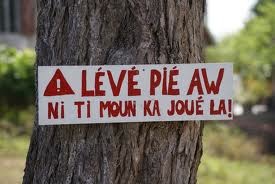Creole and Pidgin: When Languages Combine
 When the word “creole” comes to mind, most people automatically think of the Louisiana-style cuisine: gumbo, beans and rice, jambalaya, crawfish étouffée, and so on (after visiting New Orleans, that’s what I immediately think of, anyway). In fact, the Creole culture we associate with that Caribbean area is a reference to the creole language spoken in those regions for centuries. So what is creole? From reading books about the south, I grew up assuming it was a skewed, southern dialect of French, but in actuality it’s much more detailed than that.
When the word “creole” comes to mind, most people automatically think of the Louisiana-style cuisine: gumbo, beans and rice, jambalaya, crawfish étouffée, and so on (after visiting New Orleans, that’s what I immediately think of, anyway). In fact, the Creole culture we associate with that Caribbean area is a reference to the creole language spoken in those regions for centuries. So what is creole? From reading books about the south, I grew up assuming it was a skewed, southern dialect of French, but in actuality it’s much more detailed than that.
When two (or more) groups of people speaking different languages are thrown together and told to make due, they start speaking a hybrid of their native languages called “pidgin,” which is generally the blending of the vocabulary of one language with the grammar of another. Historically, this has occurred in the context of colonization, and pidgin languages often vanish as soon as the colonizers go home. For example, a variety of Pidgin Russian was spoken in Manchuria until the end of World War II, when the Russian settlers packed up and left. On the other hand, there are instances of pidgin languages lingering, such as Chinese Pidgin English (Chinglish), which was a prevalent form of communication between traders and bureaucrats in 17th century Canton. It lasted nearly three centuries, at which point it became more beneficial for the Chinese to learn how to speak English.
 When a pidgin language actually supplants the speakers’ native languages, becoming the primary language of the next generation, that is when it becomes creole. (To this day, linguists are baffled at how exactly this happens, and why in some cases a pidgin language evolves into creole, when in other cases one of the native languages wins out.) However, creole languages are agreed to be natural, and interestingly, they are grammatically more similar with each other than with their parent languages. (Another quirk none of the experts know how to explain.)
When a pidgin language actually supplants the speakers’ native languages, becoming the primary language of the next generation, that is when it becomes creole. (To this day, linguists are baffled at how exactly this happens, and why in some cases a pidgin language evolves into creole, when in other cases one of the native languages wins out.) However, creole languages are agreed to be natural, and interestingly, they are grammatically more similar with each other than with their parent languages. (Another quirk none of the experts know how to explain.)
The French word creole, taken from the Spanish criollo, can be traced back to the Latin word creare, meaning “to create.” Since many of the most high-profile creole languages in use today came into being in the context of colonization, they generally have traits in common with the languages of Europe’s four main colonizers: English, Spanish, French, and Portuguese. As most of these melded with indigenous or western African dialects, due to the slave trade, creole languages were viewed by colonists as corrupted and lower-class versions of the mother tongue and stamped out whenever possible.
Today, linguistic views regarding creole languages are evolving as new theories come to light. Some are claiming that a pidgin language is not a necessary precursor to creole, that the thought process going into the creation of pidgin is entirely different from that going into the creation of creole; a pidgin language is the result of groups of people with only a superficial interest in communication, whereas creole is the result of true absorption of another’s vocabulary and grammar. It has even been suggested that the formation of the Germanic languages is a result of a creole language being formed from Indo-European and non-Indo-European languages. In this case, English itself would be the linguistic offspring of creole, making the long-term possibilities of language hybridization more intriguing than we could have previously imagined.
Do you have any experience speaking a creole language?
